New products at Crocus
by Sarah - April 16th, 2010.Filed under: Crocus, New Products.
New items today at Crocus
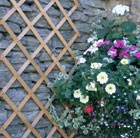
riveted-diamond-trellis £24.99
Premium, super-strong, durable trellis made from high quality hardwoods or redwoods. Riveted with zinc plated rivets.
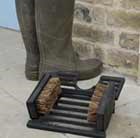
cast-iron-boot-jack £16.99
Stylish and good-looking, this cast-iron welly jack is ideal for removing any type of footwear with ease. It includes two stiff side brushes to enable your footwear to be cleaned down easily prior to taking them off.Size: height 9 x length 28 x width 22cm

sweet pea collection £12.99
The sweet pea was introduced to the UK in 1699 when a Sicilian monk, Francis Cupani, sent seeds of this fragrant annual to Dr Robert Uvedale, a teacher from Enfield, Middlesex. Thanks to its gorgeous scent the sweet pea gained popularity throughout the centuries. Over four hundred years later the range of colours has increased enormously, but many of the modern varieties lack the scent of their older uncles and aunts.This collection of rare, old fashioned sweet peas contains ten plants in individual, 8cm pots from a selection of the following varieties:America – bred in 1896 has flowers white striped with redAnnie B Gilroy – cerise blooms and was bred in 1909Apricot Sprite – attractive shades of glowing apricotCountess Cadogan – bred in 1899 is violet and blue bicolour flowersCream Southbourne – luscious cream flowersCupanis Original – the original plant from 1699, has purple and blue bicolour flowersHenry Eckford – bred in 1906 has bright orange bloomsJanet Scott – bright pink flowers and was bred in 1903Lord Nelson – bred in 1907 has flowers of navy blueMrs Collier – bred in 1907 has cream bloomsMatucana – maroon and purple flowers introduced into the UK in 1699Painted Lady – lovely pink and white bicoloured flowers and was bred in 1737Prima Dona – pink self-hooded flowers and was bred in 1896Violet Queen – bred in 1877 has violet self-hooded flowersWinston Churchill – rich crimson red bloomsPrincess Elizabeth – salmon pink with creamy buff bloomsMrs R. Bolton – light pink bloomsAir Warden – scarlet cerise bloomsGeranium Pink – cerise pink , scuffed with orange bloomsLeamington – pale sky blue bloomsRed Ensign – scarlet red bloomsWhite Ensign – pure white bloomsBlue Velvet – deep sea blue flowersThis mixed collection has been put together specifically for Crocus by our favourite sweet pea specialist. Each plant will have been cut back once so that you get a nice, seedling plant that should be at least 5cm (2in) tall.Plant Care: To make sure you keep the plants in top condition spray regularly with a fungicide as all sweet peas are prone to mildew and feed with a high potash, such as Tomorite for plenty of flowers. Don’t forget to keep cutting the flowers so that you get plenty more! Please note that the individual plants are not labelled, and as sweet peas are annuals, they will only last for one summer
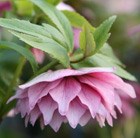
hellebore £10.99
Position: partial shadeSoil: any moist, neutral to alkaline soil, including heavy soilRate of growth: average Flowering period: February to AprilOther features: all parts of the plant cause severe discomfort if ingested; the sap may cause skin irritation; dark greyish-green leaves give off an unpleasant odour when crushedHardiness: fully hardyShowy, nodding or outward-facing, saucer-shaped, pink double flowers appear from late winter to early spring. The handsome evergreen foliage is leathery, deeply cut and dark green. This lenten rose is grown from seed, so colour variations may occur, and some are speckled inside. It looks best planted in groups at the front of a partially shady mixed border, or under shrubs among spring-flowering bulbs. In former times, hellebores were planted close to cottage doors to prevent evil spirits crossing the threshold.Garden care: A top tip from the Crocus crew is to cut back the old leaves to the ground in January or February. This will show off the emerging flowers to best effect and it also helps to get rid of foliar diseases such as hellebore leaf spot. When planting, add lots of well-rotted leaf mould or organic matter to the planting hole. Apply a generous 5-7cm (2-3in) mulch of well-rotted organic matter around the base of the plant in autumn and provide a top-dressing of general fertiliser each spring.
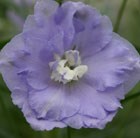
delphinium £8.99
Position: full sunSoil: fertile, well-drained soilRate of growth: average Flowering period: June and July Flower colour: mauve-blueOther features: all parts of the plant may cause severe discomfort if ingested; contact with the sap may cause skin irritation; excellent cut-flowers;Hardiness: fully hardyThis lovely delphinium, the favourite of many growers, is a real asset to any garden. It is delicate with soft mauvish-blue spires and additionally has the added attraction of slightly frilled edges to the pretty individual florets. These large florets have clear white eyes perfectly complimenting the delicate nature of the flowers.Garden care: Stake with bamboo canes in mid-spring. During the growing season apply a balanced liquid fertiliser every 2-3 weeks and wearing gloves cut back the faded flower stems to a flowering sideshoot. At the end of autumn cut back and compost the faded flower-stems.
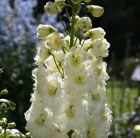
delphinium £8.99
Position: full sunSoil: fertile, well-drained soilRate of growth: average Flowering period: June and July Flower colour: deep creamOther features: all parts of the plant may cause severe discomfort if ingested; contact with the sap may cause skin irritation; excellent cut-flowers;Hardiness: fully hardyA subtle and beautiful delphinium with spires of deep cream cream. The florets are large and closely placed on tall stems, and open over a three to four week period, depending on the weather. Great for adding height and colour to any sunny border as the stems can reach 1.7m (½ft) tall. Like all delphiniums, it can cope withstand very cold weather and will vigorously in most garden soils.Garden care: Stake with bamboo canes in mid-spring. During the growing season apply a balanced liquid fertiliser every 2-3 weeks and wearing gloves cut back the faded flower stems to a flowering sideshoot. At the end of autumn cut back and compost the faded flower-stems
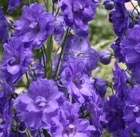
delphinium £8.99
Position: full sunSoil: fertile, well-drained soilRate of growth: average Flowering period: June and JulyHardiness: fully hardyGrower Simon Langdon says that this isone of the slightly shorter plants in his range of beautiful elatum delphiniums. The flowers are very large and closely placed together in a pretty deep lavender blue. The centre of the flower displays a further group of petals with no obvious eye showing. Like all delphiniums, these look fantastic planted in bold clumps as part of a cottage-gardenscheme or towards the back of a well-drained, sunny border, where theywill add height and bold splashes of colour. They make excellent cut flowers. Further flowering in the autumn may be encouraged by cutting back after flowering.Garden care: Protect young foliage against slug and snail damage in spring. Stakewith bamboo canes in mid-spring, before the flowers appear. During thegrowing season, apply a balanced liquid fertiliser every 2-3 weeks andwearing gloves cut back the faded flower-stems to a floweringside-shoot to encourage repeat flowering. At the end of autumn cut backand compost the faded flower-stems.
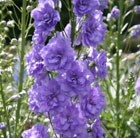
delphinium £8.99
Position: full sunSoil: fertile, well-drained soilRate of growth: average Flowering period: June and July Flower colour: deep mauveOther features: all parts of the plant may cause severe discomfort if ingested; contact with the sap may cause skin irritation; excellent cut-flowers;Hardiness: fully hardyA lovely delphinium with deep mauve, double flowers on tall spikes. A lovely plant to add old-fashioned elegance to any sunny border where it can reach 1.5m (5ft) tall. The delicate buds open over a period of two to three weeks gradually showing the full glory of the plant.Garden care: Stake with bamboo canes in mid-spring. During the growing season apply a balanced liquid fertiliser every 2-3 weeks and wearing gloves cut back the faded flower stems to a flowering sideshoot. At the end of autumn cut back and compost the faded flower-stems

delphinium £8.99
Position: full sunSoil: fertile, well-drained soilRate of growth: average Flowering period: June and JulyHardiness: fully hardy Towering spires of double purple flowers with white eyes appear in June and July on tall stems with deeply cut, mid-green leaves. These show-stopper delphiniums look great planted in bold clumps as part of a cottage-garden scheme or towards the back of a well-drained, sunny border where they will add height and bold splashes of colour. They make excellent cut flowers.Garden care: Protect young foliage against slug and snail damage in spring. Stakewith bamboo canes in mid-spring, before the flowers appear. During thegrowing season, apply a balanced liquid fertiliser every 2-3 weeks andwearing gloves cut back the faded flower-stems to a floweringside-shoot to encourage repeat flowering. At the end of autumn cut backand compost the faded flower-stems.
delphinium £8.99
pachyphragma £7.99
riveted-diamond-trellis £7.99
masterwort £7.99
prairie mallow £6.99
Spanish sage £6.99
sneezeweed £6.99
dahlia (syn. Nuit D’ete) £6.99
dahlia £6.99






